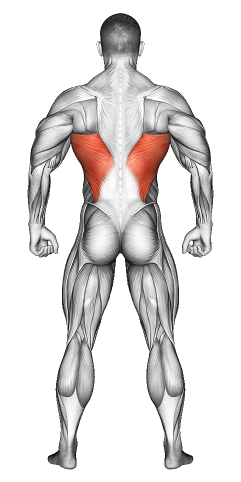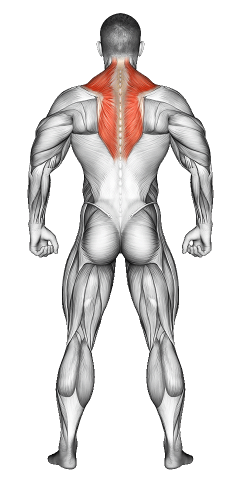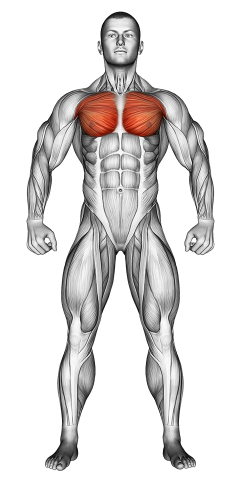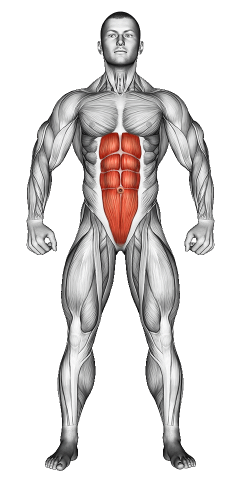Meadows Row: Video Tutorial & Exercise Guide

Written By: Claude Michael
Updated: Oct 13, 2024
| Workout | Meadows Row |
| Primary Muscle Group | Lats |
| Secondary Muscle Group | Abs, Chest Shoulders |
| Equipment Required | T-bar machine, Landmine Attachment |
| Force Type | Pull |
| Mechanics | Compound |
| Exercise Type | Strength |
| Difficulty | Intermediate |
Meadows Row: Video Tutorial & Exercise Guide
Meadows Row: Step-by-Step Guide
- Step 1: Set up a barbell in a landmine attachment or secure one end of the barbell into a corner. Stand beside the barbell, with the loaded end in front of you. Your inside leg should be slightly bent, and your outside leg should be positioned back.
- Step 2: Hinge forward at the hips while keeping your back straight. Reach down and grasp the barbell with an overhand grip, about 12-18 inches from the weighted end.
- Step 3: Begin the row by pulling the barbell up toward your torso, driving your elbow back and keeping it close to your body. Squeeze your shoulder blade at the top of the movement.
- Step 4: Pause briefly at the top of the movement, then slowly lower the barbell back to the starting position, fully extending your arm.
- Step 5: Repeat for the desired number of reps, then switch sides and repeat the exercise on the other arm.
Meadows Row: Overview
The Meadows Row is a unilateral (single-arm) exercise that targets the upper back, lats, and shoulders, named after bodybuilder John Meadows. The unique angle and grip used in this exercise create a deep stretch in the lats and allow for a strong contraction, making it an excellent movement for building upper back thickness and strength.
This exercise is performed using a landmine setup, where one end of a barbell is secured in a corner or landmine attachment. The Meadows Row emphasizes the back and shoulders while also engaging the core and stabilizer muscles due to the bent-over position.
Meadows Row: Benefits
The Meadows Row is highly effective for targeting the latissimus dorsi, rhomboids, and trapezius muscles, helping to develop back width and thickness. This exercise also enhances grip strength and improves shoulder stability, making it a great movement for athletes and lifters looking to improve their pulling strength.
The angled body position and unilateral movement help correct muscle imbalances between the left and right sides of the body. The deep stretch in the lats at the bottom of the row encourages full muscle activation, promoting both muscle growth and flexibility.
Additionally, the Meadows Row engages the core and lower back, improving overall stability and balance during the movement.
Meadows Row: Pro Tips & Advanced Techniques
Focus on keeping your back flat and core engaged throughout the movement to avoid rounding your spine. Make sure to pull the barbell toward your torso by driving your elbow back and squeezing your shoulder blade at the top. For an added challenge, slow down the eccentric phase (lowering the barbell) to increase time under tension. Ready to build a thicker, stronger back? Let’s row!
Meadows Row: Progression Plan
Beginner
Intermediate
Advanced
Meadows Row: Frequently Asked Questions (FAQs)
What muscles do Meadows Rows target?
+This exercise primarily targets the latissimus dorsi, trapezius, and rhomboids, with secondary engagement of the biceps, forearms, and core for stabilization.
Is the Meadows Row suitable for beginners?
+Yes, beginners can perform this exercise with lighter weights to focus on mastering proper form. The unilateral movement makes it easier to focus on developing each side of the back evenly.
How can I make the Meadows Row more challenging?
+To increase the difficulty, use heavier weights, slow down the eccentric phase, or add a pause at the top of the row for increased time under tension and muscle activation.
How often should I include Meadows Rows in my routine?
+Include this exercise 2-3 times per week as part of your back workout. It pairs well with other pulling movements like pull-ups and deadlifts for a comprehensive back routine.
What common mistakes should I avoid?
+Avoid rounding your back or using momentum to lift the weight. Focus on keeping your core engaged and using your back muscles to drive the row, not your arms or shoulders.
Share
Don’t Wish for It, Work for It – Join the FlexXP Newsletter Today!
Thank you for signing up for the FlexXP Newsletter!
This site is protected and the Google Privacy Policy and Terms of Service apply.



